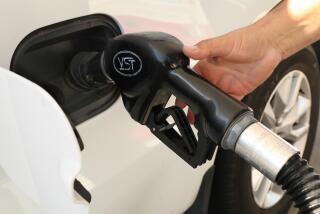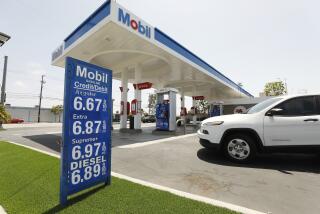For Some, It’s a Gas to Cheat the Fuel Gauge
- Share via
Safety, maturity and conservatism seem to fly out the window for many motorists who get a precarious thrill out of seeing how far they can push their gas gauge past “empty” before refueling.
No one can say for certain how many people run out of gas, but even the limited statistics available indicate that it is a comically common human failure.
The Automobile Club of Southern California reports that its roadside assistance program fielded about 90,000 calls in 1999 from motorists stranded on the highway without a drop of gas.
The Freeway Service Patrol--a program run by state agencies in seven metropolitan areas, including greater Los Angeles--came to the aid of 60,000 out-of-gas nomads on California interstates during 1998, according to the Highway Patrol.
An educated guess is that tens of thousands of other drivers run out of gas and deal with it themselves or through other assistance programs.
Fuel gauges are so imprecise--big fat needles that move imperceptibly against the “E” that marks “empty.” Nonetheless, drivers study their gauges intently and often think they can cheat them to squeeze a few more miles out of a tank of gasoline.
Of course, most motorists now and then are too busy to stop for gas, figuring they can make one more trip or one more leg of a commute. So they push onward until their engines begin to sputter and die.
Even when people do run out of gas, they sometimes refuse to believe it.
When tow trucks haul vehicles to Family Smog & Auto in Bellflower, owner Joe Forgacs says, the motorists often complain that their cars or trucks don’t work.
Of course not.
The problem, Forgacs says, is that they don’t have any gas.
And they are the lucky ones, police say.
Take for example, the man who ran out of gas on the 805 Freeway in San Diego two years ago. He returned to his car with a gallon of fuel, but it still wouldn’t start. Somebody had stolen the battery in his brief absence.
More tragically, a mother of five was hit and killed on a Burbank road in 1997 as she tried to put gas into her stranded car. A house painter who had stopped to help her was struck and injured.
*
Why do people put themselves in that position? Such behavior is an example of the same tendency to procrastinate that can be seen in the millions of Americans who fail to file tax returns on time or to claim their bank deposits before they are turned over to the state because of inactivity.
“We don’t sanction the idea of running out of gas,” says Les Waas, president of the Procrastinators Club of America, based in Philadelphia.
“A good procrastinator is one who puts off the right thing so he has more time to do important things, like getting gas.”
Waas, who once ran out of fuel in an airplane while in the Navy, says it is a good idea to run out of gas once--because most people then learn never to let it happen it again.
But once is not necessarily enough for those who become expert at running out of gas. A proficient gas scofflaw can coast for up to a mile and roll right up to a pump with a dead engine.
Carrying extra gasoline is another common ploy, though that can pose an explosive hazard.
Spare Tank, a product developed by a Harvard University chemical engineer to address that danger, is a gasoline substitute that the manufacturer says can be stored safely, and indefinitely, in the trunk. The product is sold on the Internet at https://www.sparetank.com, for $9.95 a quart or $19.95 a gallon.
Teenagers are wizards at returning their parents’ vehicles with the needle on empty after a night out. Not surprisingly, it is teenagers who can frequently be seen buying gas in pocket-change quantities, often a few blocks from home.
Kramer, the wild-haired New Yorker on “Seinfeld,” epitomized the gas scofflaw in one episode in which he egged on a car salesman to defy a low gas reading during a test drive. When the car finally sputtered to a halt late at night, Kramer walked away, saying he would think about whether he really wanted to buy the car.
Apart from inconvenience and embarrassment, running out of gas can also create serious mechanical problems in newer vehicles.
Virtually all late-model passenger cars and trucks use electric fuel pumps, which can overheat and fail if they don’t have fuel running through them. The pumps will cycle off after two seconds without gasoline and then overheat when the driver responds by repeatedly attempting to start the vehicle, says Forgacs of Family Smog & Auto.
“Those babies are expensive--$300 for just the part,” he says. “On some cars you have to pull the tank to replace it.”
Forgacs cites the example of some 1985 Pontiacs, which require the mechanic to drop the rear suspension to remove the fuel tank.
“It’s a full-day job,” he says.
The worst damage from a dry tank that Forgacs has seen occurred on an Infiniti Q45 sedan, which suffered a damaged fuel pump and a melted relay assembly in the trunk. The entire rear seat and deck assembly had to be removed to replace the relay, which alone cost $500. By the time the car left the shop, Forgacs says, it had $1,000 of repairs.
It’s easy to avoid trouble by keeping the tank above the quarter-full mark. An even surer way to watch your fuel is to reset the trip odometer after each refueling and calculate how many miles you can drive on a full tank.
For example, if your car gets 20 miles to the gallon and you have a 15-gallon tank, your absolute range is 300 miles. Thus you will be fairly safe by refueling every 280 miles.
But for a lot of people, apparently, that would take all the fun out of driving.
*
If you would like to share your story about running out of gas, write to Ralph Vartabedian in care of Your Wheels, Business Section, Los Angeles Times, 202 W. 1st St., Los Angeles, CA 90012. E-mail: ralph.vartabedian@latimes.com. Please do not telephone.
More to Read
Sign up for Essential California
The most important California stories and recommendations in your inbox every morning.
You may occasionally receive promotional content from the Los Angeles Times.














